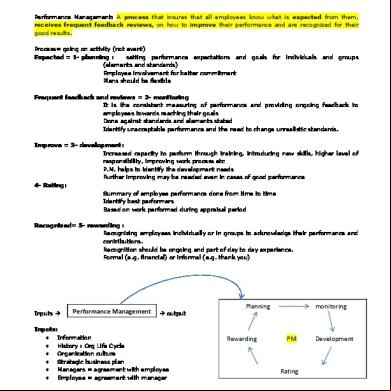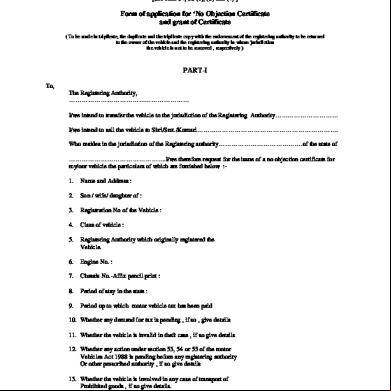Performance Management And Coaching.ppt 28203u
This document was ed by and they confirmed that they have the permission to share it. If you are author or own the copyright of this book, please report to us by using this report form. Report 445h4w
Overview 1s532p
& View Performance Management And Coaching.ppt as PDF for free.
More details 6h715l
- Words: 1,517
- Pages: 41
Coaching and Performance Management Chapter 10
Werner & DeSimone (2006)
1
Thoughts for Discussion Most employees “already know what they should do and how to do it.” Performance management is “simply a matter of expecting tasks to be done correctly and on time.” “If the problem does not go away, the employee must be stupid, lazy, or have a „bad attitude.‟ Therefore, punishment is called for.” Werner & DeSimone (2006)
2
The Need for Coaching Too many managers use a negative approach to managing behavior Alternative: conflict avoidance – and overload the good workers Sometimes the only time the supervisor talks to a worker is when there is a problem Werner & DeSimone (2006)
3
Coaching – A Positive Approach An active and positive management approach Employees should know:
What to do How to do it Problem solving
Participative Management
Workers have a voice in their work Werner & DeSimone (2006)
4
Coaching and Performance Management Performance appraisal
The first step
Performance management
Employee goal setting Coaching Rewards Individual development Werner & DeSimone (2006)
5
Definitions of Coaching No single accepted definition A mutual discussion leading to improved performance and positive relationships A process to encourage employees to:
Accept responsibility for their actions
Achieve and sustain superior performance
Work as partners in achieving organizational goals and effectiveness Werner & DeSimone (2006)
6
Supervisor‟s Role in Coaching A supervisor: Should be motivated to see the work group succeed Can use all information on hand Has opportunity to coach and counsel Has authority to carry out coaching Is responsible for unit‟s effectiveness Werner & DeSimone (2006)
7
HRD Professional‟s Coaching Role Provides training for coaches Provides training to correct performance problems Provides organizational development Coaching is an HRD intervention
Werner & DeSimone (2006)
8
Coaching to Improve Poor Performance Defining poor performance Responding to poor performance Conducting a coaching analysis Using the coaching discussion
Werner & DeSimone (2006)
9
Defining Poor Performance Definition: “Specific, agreed upon deviations from expected behavior” Performance must be evaluated against some standard or expected level of performance Standards and expected levels of performance must be known by the supervisor and the worker Werner & DeSimone (2006)
10
Types of Standards Absolute
Same scale or standard is applied to all subordinates
Relative
Performance is evaluated relative to the performance of others
Werner & DeSimone (2006)
11
Deviant Workplace Behavior Production deviance
Working slowly, leaving early
Property deviance
Sabotage, lying about hours worked
Political deviance
Showing favoritism, gossiping
Personal aggression
Harassment, abuse, stealing, etc. Werner & DeSimone (2006)
12
Responding to Poor Performance Causal Attribution Theory
People assign causes to behavior Different actions are likely based on internal versus external attributions
Fundamental Attribution Error
Assumes or attributes behavior comes from a cause within a person Supervisor may overlook other causes Werner & DeSimone (2006)
13
Coaching Analysis The process of analyzing the factors that contribute to unsatisfactory performance Deciding on the appropriate response to improve performance
Werner & DeSimone (2006)
14
Steps in Conducting Coaching Analysis 1.
Identify the unsatisfactory employee performance.
2.
Is it worth your time and effort to address?
3.
Do subordinates know that their performance is not satisfactory?
4.
Do subordinates know what is supposed to be done?
5.
Are there obstacles beyond the employee‟s control?
6.
Does the subordinate know how to do what must be done?
7.
Does a negative consequence follow effective performance?
8.
Does a positive consequence follow nonperformance?
9.
Could the subordinate do it if he or she wanted to?
SOURCE: Fournies, F. F. (1978). Coaching for improved work performance. New York: Van Nostrand Reinhold.
Werner & DeSimone (2006)
15
Steps to Follow in Conducting a Coaching Analysis Identify the unsatisfactory performance Decide if it‟s worth YOUR time and effort Find out if the worker knows that their work is not satisfactory Does the worker know what is to be done? Werner & DeSimone (2006)
16
Steps to Follow in Conducting a Coaching Analysis – 2 Are there obstacles beyond the worker‟s control? Does worker know HOW to do the job? Does a negative consequence follow effective performance?
Werner & DeSimone (2006)
17
Steps to Follow in Conducting a Coaching Analysis – 3 Does a positive consequence follow nonperformance? Can the worker do the job if he/she wants to? Can the job or task be modified? What if the problem persists?
Werner & DeSimone (2006)
18
The Coaching Discussion Kinlaw‟s Approach:
Confronting or presenting
Using reactions to develop information
Resolving or resolution
Werner & DeSimone (2006)
19
The Coaching Discussion – 2 The Fournies Approach:
Get agreement with worker that a problem exists Mutually discuss alternative solutions to the problem Mutually agree on actions to be taken Follow-up to measure results Recognize achievement when it happens Werner & DeSimone (2006)
20
Critical Points for Both You need specific objectives or goals Goals must be mutually understood and agreed upon
Werner & DeSimone (2006)
21
What if Coaching Fails? Transfer the employee to work that the employee can do Terminate for substandard performance Have adequate documentation of coaching efforts to termination! Werner & DeSimone (2006)
22
Maintaining Effective Performance and Encouraging Superior Performance Must reward good performance Use:
Goal Setting Job redesign Worker participation Job ownership
Werner & DeSimone (2006)
23
Manager-Coach Responsibilities Provide evaluation
Self-evaluation can be difficult People often focus on their weaknesses
Manager-coach can:
see the big picture make suggestions for improvement reinforce company values Werner & DeSimone (2006)
24
Skills Needed for Effective Coaching Communication skills Interpersonal skills
Werner & DeSimone (2006)
25
Communication Skills Writing Speaking Active listening
Werner & DeSimone (2006)
26
Writing Skills Acceptable grammar and spelling Clear and concise style Example: Facts, Discussion, Recommendation (FDR)
Werner & DeSimone (2006)
27
Speaking Skills Specific and descriptive Focused on the issue at hand Polite and respectful Focused on the problem, not the person Objective, not based on feelings
Werner & DeSimone (2006)
28
Active Listening More than, “I hear you” Must listen for what the other person is trying to say Specific techniques are needed It is NOT easy!
Werner & DeSimone (2006)
29
How to Listen Actively Mirror back what the individual says:
“So you think that you are doing the right thing. Is there more?”
Paraphrase and summarize:
“So you feel you are doing the job the way you were taught to do it, and that any quality errors are not your fault. Is that right? Is there more?” Werner & DeSimone (2006)
30
How to Listen Actively – 2 Use open-ended questions to get information:
Can‟t be answered with simple yes or no
Use closed questions to get a yes or no answer See Tables 10-2 and 10-3 Active listening takes a lot of work! Werner & DeSimone (2006)
31
Interpersonal Skills Show respect for the individual Focus on the present and future
Not on the past!
Be objective Plan ahead
Werner & DeSimone (2006)
32
Interpersonal Skills – 2 Affirm the efforts of others Be consistent Build trust Demonstrate commitment to and respect for others Integrity, Integrity, Integrity!!!
Werner & DeSimone (2006)
33
Effectiveness of Coaching Hard to measure objectively Can be measured in many ways Some coaches ARE better than others Others need to keep working to improve their coaching skills; good coaching skills can be learned
Werner & DeSimone (2006)
34
Performance Appraisal Interview Major source of employee Gives employee the chance for and participation in the process
Allows the coach to affirm his/her Provides opportunity for constructive criticism – both ways
Focus on the problem, not the “personality”
Werner & DeSimone (2006)
35
Performance Appraisal Interview – 2 Time to mutually set next period‟s goals and objectives Provides mutually understood basis for improvement
Werner & DeSimone (2006)
36
Training the Supervisor/Appraiser Effective training: Helps the appraiser to be credible Promotes acceptance of appraisal Helps provide accurate Assists the supervisor in demonstrating for the employee Werner & DeSimone (2006)
37
Organizational Organization needs to their coaching and performance management efforts Takes time, training, and money Needs to be part of the corporate culture Needs to be linked to compensation, rewards, and promotion systems Werner & DeSimone (2006)
38
Coaching in a Nutshell Worker participates in discussions Worker helps set goals for improvement is specific and behavioral Coaches are ive and helpful Supervisor needs to know the worker‟s job Coaches need and training Werner & DeSimone (2006)
39
Summary Managers must ensure effective employee performance Positive coaching provides a great opportunity for individual improvement Allows worker to:
accept responsibility achieve superior performance work towards organizational goals Werner & DeSimone (2006)
40
Summary – 2 Good coaches needs:
Effective communication skills
Effective interpersonal skills
Integrity
Effective performance appraisal skills
Is it any wonder that good coaches can be hard to find? Werner & DeSimone (2006)
41
Werner & DeSimone (2006)
1
Thoughts for Discussion Most employees “already know what they should do and how to do it.” Performance management is “simply a matter of expecting tasks to be done correctly and on time.” “If the problem does not go away, the employee must be stupid, lazy, or have a „bad attitude.‟ Therefore, punishment is called for.” Werner & DeSimone (2006)
2
The Need for Coaching Too many managers use a negative approach to managing behavior Alternative: conflict avoidance – and overload the good workers Sometimes the only time the supervisor talks to a worker is when there is a problem Werner & DeSimone (2006)
3
Coaching – A Positive Approach An active and positive management approach Employees should know:
What to do How to do it Problem solving
Participative Management
Workers have a voice in their work Werner & DeSimone (2006)
4
Coaching and Performance Management Performance appraisal
The first step
Performance management
Employee goal setting Coaching Rewards Individual development Werner & DeSimone (2006)
5
Definitions of Coaching No single accepted definition A mutual discussion leading to improved performance and positive relationships A process to encourage employees to:
Accept responsibility for their actions
Achieve and sustain superior performance
Work as partners in achieving organizational goals and effectiveness Werner & DeSimone (2006)
6
Supervisor‟s Role in Coaching A supervisor: Should be motivated to see the work group succeed Can use all information on hand Has opportunity to coach and counsel Has authority to carry out coaching Is responsible for unit‟s effectiveness Werner & DeSimone (2006)
7
HRD Professional‟s Coaching Role Provides training for coaches Provides training to correct performance problems Provides organizational development Coaching is an HRD intervention
Werner & DeSimone (2006)
8
Coaching to Improve Poor Performance Defining poor performance Responding to poor performance Conducting a coaching analysis Using the coaching discussion
Werner & DeSimone (2006)
9
Defining Poor Performance Definition: “Specific, agreed upon deviations from expected behavior” Performance must be evaluated against some standard or expected level of performance Standards and expected levels of performance must be known by the supervisor and the worker Werner & DeSimone (2006)
10
Types of Standards Absolute
Same scale or standard is applied to all subordinates
Relative
Performance is evaluated relative to the performance of others
Werner & DeSimone (2006)
11
Deviant Workplace Behavior Production deviance
Working slowly, leaving early
Property deviance
Sabotage, lying about hours worked
Political deviance
Showing favoritism, gossiping
Personal aggression
Harassment, abuse, stealing, etc. Werner & DeSimone (2006)
12
Responding to Poor Performance Causal Attribution Theory
People assign causes to behavior Different actions are likely based on internal versus external attributions
Fundamental Attribution Error
Assumes or attributes behavior comes from a cause within a person Supervisor may overlook other causes Werner & DeSimone (2006)
13
Coaching Analysis The process of analyzing the factors that contribute to unsatisfactory performance Deciding on the appropriate response to improve performance
Werner & DeSimone (2006)
14
Steps in Conducting Coaching Analysis 1.
Identify the unsatisfactory employee performance.
2.
Is it worth your time and effort to address?
3.
Do subordinates know that their performance is not satisfactory?
4.
Do subordinates know what is supposed to be done?
5.
Are there obstacles beyond the employee‟s control?
6.
Does the subordinate know how to do what must be done?
7.
Does a negative consequence follow effective performance?
8.
Does a positive consequence follow nonperformance?
9.
Could the subordinate do it if he or she wanted to?
SOURCE: Fournies, F. F. (1978). Coaching for improved work performance. New York: Van Nostrand Reinhold.
Werner & DeSimone (2006)
15
Steps to Follow in Conducting a Coaching Analysis Identify the unsatisfactory performance Decide if it‟s worth YOUR time and effort Find out if the worker knows that their work is not satisfactory Does the worker know what is to be done? Werner & DeSimone (2006)
16
Steps to Follow in Conducting a Coaching Analysis – 2 Are there obstacles beyond the worker‟s control? Does worker know HOW to do the job? Does a negative consequence follow effective performance?
Werner & DeSimone (2006)
17
Steps to Follow in Conducting a Coaching Analysis – 3 Does a positive consequence follow nonperformance? Can the worker do the job if he/she wants to? Can the job or task be modified? What if the problem persists?
Werner & DeSimone (2006)
18
The Coaching Discussion Kinlaw‟s Approach:
Confronting or presenting
Using reactions to develop information
Resolving or resolution
Werner & DeSimone (2006)
19
The Coaching Discussion – 2 The Fournies Approach:
Get agreement with worker that a problem exists Mutually discuss alternative solutions to the problem Mutually agree on actions to be taken Follow-up to measure results Recognize achievement when it happens Werner & DeSimone (2006)
20
Critical Points for Both You need specific objectives or goals Goals must be mutually understood and agreed upon
Werner & DeSimone (2006)
21
What if Coaching Fails? Transfer the employee to work that the employee can do Terminate for substandard performance Have adequate documentation of coaching efforts to termination! Werner & DeSimone (2006)
22
Maintaining Effective Performance and Encouraging Superior Performance Must reward good performance Use:
Goal Setting Job redesign Worker participation Job ownership
Werner & DeSimone (2006)
23
Manager-Coach Responsibilities Provide evaluation
Self-evaluation can be difficult People often focus on their weaknesses
Manager-coach can:
see the big picture make suggestions for improvement reinforce company values Werner & DeSimone (2006)
24
Skills Needed for Effective Coaching Communication skills Interpersonal skills
Werner & DeSimone (2006)
25
Communication Skills Writing Speaking Active listening
Werner & DeSimone (2006)
26
Writing Skills Acceptable grammar and spelling Clear and concise style Example: Facts, Discussion, Recommendation (FDR)
Werner & DeSimone (2006)
27
Speaking Skills Specific and descriptive Focused on the issue at hand Polite and respectful Focused on the problem, not the person Objective, not based on feelings
Werner & DeSimone (2006)
28
Active Listening More than, “I hear you” Must listen for what the other person is trying to say Specific techniques are needed It is NOT easy!
Werner & DeSimone (2006)
29
How to Listen Actively Mirror back what the individual says:
“So you think that you are doing the right thing. Is there more?”
Paraphrase and summarize:
“So you feel you are doing the job the way you were taught to do it, and that any quality errors are not your fault. Is that right? Is there more?” Werner & DeSimone (2006)
30
How to Listen Actively – 2 Use open-ended questions to get information:
Can‟t be answered with simple yes or no
Use closed questions to get a yes or no answer See Tables 10-2 and 10-3 Active listening takes a lot of work! Werner & DeSimone (2006)
31
Interpersonal Skills Show respect for the individual Focus on the present and future
Not on the past!
Be objective Plan ahead
Werner & DeSimone (2006)
32
Interpersonal Skills – 2 Affirm the efforts of others Be consistent Build trust Demonstrate commitment to and respect for others Integrity, Integrity, Integrity!!!
Werner & DeSimone (2006)
33
Effectiveness of Coaching Hard to measure objectively Can be measured in many ways Some coaches ARE better than others Others need to keep working to improve their coaching skills; good coaching skills can be learned
Werner & DeSimone (2006)
34
Performance Appraisal Interview Major source of employee Gives employee the chance for and participation in the process
Allows the coach to affirm his/her Provides opportunity for constructive criticism – both ways
Focus on the problem, not the “personality”
Werner & DeSimone (2006)
35
Performance Appraisal Interview – 2 Time to mutually set next period‟s goals and objectives Provides mutually understood basis for improvement
Werner & DeSimone (2006)
36
Training the Supervisor/Appraiser Effective training: Helps the appraiser to be credible Promotes acceptance of appraisal Helps provide accurate Assists the supervisor in demonstrating for the employee Werner & DeSimone (2006)
37
Organizational Organization needs to their coaching and performance management efforts Takes time, training, and money Needs to be part of the corporate culture Needs to be linked to compensation, rewards, and promotion systems Werner & DeSimone (2006)
38
Coaching in a Nutshell Worker participates in discussions Worker helps set goals for improvement is specific and behavioral Coaches are ive and helpful Supervisor needs to know the worker‟s job Coaches need and training Werner & DeSimone (2006)
39
Summary Managers must ensure effective employee performance Positive coaching provides a great opportunity for individual improvement Allows worker to:
accept responsibility achieve superior performance work towards organizational goals Werner & DeSimone (2006)
40
Summary – 2 Good coaches needs:
Effective communication skills
Effective interpersonal skills
Integrity
Effective performance appraisal skills
Is it any wonder that good coaches can be hard to find? Werner & DeSimone (2006)
41










